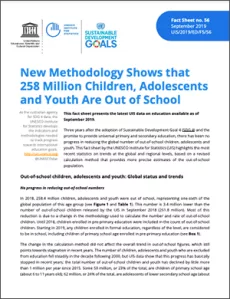New Methodology Shows that 258 Million Children, Adolescents and Youth Are Out of School
Fact sheet, September 2019
About
This fact sheet presents the latest UIS data on education available as of September 2019.
Despite the extensive work being done to implement Sustainable Development Goal 4 (SDG4), which promises to provide universal primary and secondary education, evidence suggests that there has been little reduction in the global numbers of out-of-school children, adolescents and youth.
In the decade that followed 2000 the numbers of out-of-school children declined at a steady rate, however, between 2010 and 2018 the number has stagnated and since 2015 has fallen by little more than 1 million per year. Some 59 million children of primary school age, 62 million adolescents and 138 million youth of upper secondary school age are currently still out of school resulting in a total figure of 259 million as of September 2018.
Regional out-of-school figures
Many countries have made great strides in reducing the number of children who do not attend school. They have achieved these successes by investing in interventions such as abolishing school fees, introducing relevant curricula, and providing scholarships to financially struggling families. Some national governments increased spending on education and invested in new classrooms, teacher recruitment and text books.
In all age groups, sub-Saharan Africa remains the region with the highest number of out-of-school children, it is also the region with the highest rate of exclusion for children who are denied the right to education. Youth of upper secondary school age have considerably higher numbers of out-of-school children than other ages groups across all regions.
Gender disparities persist at the regional level
Fifty-four per cent of the 376 million out-of-school children, adolescents and youth in 2000 were female, this figure has fallen to 50 per cent in 2018 but these global averages do not indicate the differences that can be found at national and regional levels.
With the exception of Latin America and the Caribbean, Europe and North America where boys are more likely to be out of school, all other regions puts girls at a disadvantage at primary school-age. The largest disparity within this age group as well as that of the lower secondary-age group can be seen in Central Asia. Latin America and the Caribbean are the closest to achieving gender parity within these two age groups. In the Upper secondary age group Eastern and South-Eastern Asia have the highest rate of disadvantaged males.

